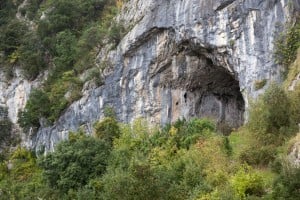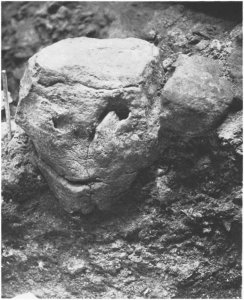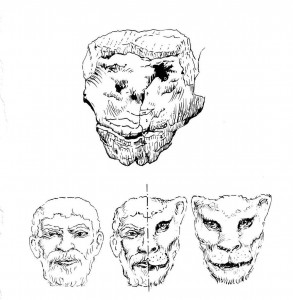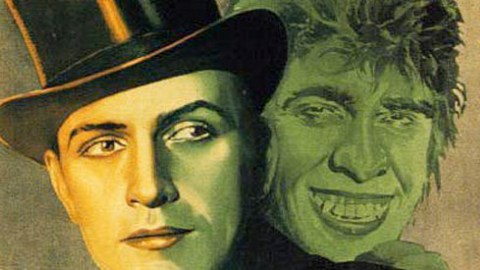Over 15,000 years ago, in a small, single-chamber cave on the northern coast of Spain, prehistoric people built a complex altar out of a huge stalagmite slab supported by antler bones.
 After months of excavating its foundation, structure and artifacts, archaeologists were able to discern a half-human, half feline face, reflecting a double theme. Apparently dualism has deep roots in the human mind.
After months of excavating its foundation, structure and artifacts, archaeologists were able to discern a half-human, half feline face, reflecting a double theme. Apparently dualism has deep roots in the human mind.
“It seems that the habit of dividing the world into opposite or opposing forces existed among prehistoric people, and we see a continuity between their way of thinking and ours,” wrote author John E. Pfeiffer, commenting on the extraordinary find.
Once the face in El Juyo was revealed, thousands of years since people used the cave for “magico-religious purposes,” something very interesting became apparent. People entering the cave at the entrance saw only the human side of the face, nearly ten meters away.
However to view the feline side, people had to come close and examine the image by the light of a lamp or torch. The effect was planned, and must have been dramatic.
As Pfeiffer tantalizingly says, “the face is half human and half beast, suggesting a Jekyll-Hyde version of human nature.”
But is it a version, or is it the truth of human nature? And if the human/beast, good/evil pattern is not the truth of human nature, why is there a dualistic way of seeing ourselves in the first place?
It’s sobering to realize that so-called human nature, and the dualistic attitude, hasn’t changed in thousands of years. When everything else changes in nature, why should human nature be the one immutable element?
Perhaps the basic reason is experience. It seems to be the quintessential self-fulfilling prophecy and vicious circle: Human nature doesn’t change because we believe it’s unchangeable, and it’s unchangeable because we have so much experience with it not changing.
There’s an old saying about the devil: It’s not that Satan is smarter than everyone else; it’s that he has so much more  experience.’ (Another quote that’s apropos: ‘The greatest triumph of the devil in the modern age is convincing people he doesn’t exist.’)
experience.’ (Another quote that’s apropos: ‘The greatest triumph of the devil in the modern age is convincing people he doesn’t exist.’)
Without digressing any further into the nature and origins of evil, it is clear that its existence, as well as the demons that trouble and possess the minds and hearts of the living, are not supernatural, but arise from the human mind and reside within collective consciousness.
Though there are still a few holdouts for the malleability of human nature, it seems to be intractable to the point of being incorrigible. But our beliefs about ourselves are as important, and probably more important than whatever the actuality of human nature is.
Did the human condition and contradiction begin with ‘original sin’ or with dualism, chillingly expressed by Robert Louis Stevenson in the “Strange Case of Dr. Jekyll and Mr. Hyde?” And is dualism the ‘original sin?’
The psychiatric interpretation places the story in the context of the split personality of an individual, one apparently good and the other evil. But psychiatry has failed both the individual and humanity in large part because it focuses solely on the individual, neglecting the larger contexts of culture and consciousness.
A more cogent interpretation of Stevenson’s novella is as an examination of the duality of human nature, specifically that good and evil exists in everyone. In this view, the failure to accept this tension and understand our shadow side results in the evil being projected onto others.
Just as with prehistoric people however, the basic approach is dualistic–seeing ourselves and the world in terms of opposites and opposing forces. The problem with dualism (which appears to be in the nature of thought itself) is that it sets up a conflict between good and evil, light and dark from the get go.
 The philosophical alternative is not ‘the world is gray’ idea that so many people these days cite ad nauseum. That’s not only a false choice; it prevents clear perception of the true and the false, and renders everything…gray.
The philosophical alternative is not ‘the world is gray’ idea that so many people these days cite ad nauseum. That’s not only a false choice; it prevents clear perception of the true and the false, and renders everything…gray.
The alternative is to see that good is not the opposite of evil; there is no relationship between the two. That’s not to take a black or white view. It just means that we can see the true as true and the false as false, while acknowledging that human beings are a complex interplay of many characteristics—personality, conditioning, culture, character, history, ethnicity, religious impulse, etc.
To the extent that we all have within us unaddressed darkness from our own families, lives and cultures, as well as from the deep past, we can be driven to evil. But the dualism between good and evil is a complete fiction. Dispelling darkness is a matter of emotionally perceiving the false within and around us and remaining with it rather than reacting to it. Then what is true and good has the space to grow within us.
The split in the human psyche is not first the product of some individual pathology, nor to any inherent aspect of human nature. The Jekyll-Hyde syndrome in the human condition is due to the strong tendency toward division and habit of suppression in the human mind.
By taking responsibility for and being mindful and curious about the dark and animal sides of our nature (which are not the same thing), we learn about ourselves all the time. Then division, duality and acting out diminish, and we grow in wisdom.
As the prehistoric cave altar attests, the human mind tends toward dualism and oppositional thinking. Indeed, dualism appears to be in the nature of thought itself. Is that the primary feature of human nature? If so, it’s one we can change.
Martin LeFevre

